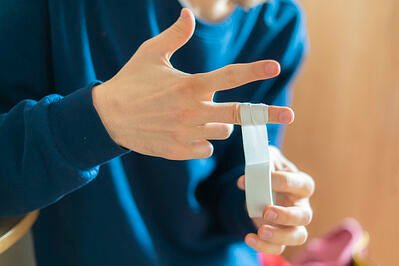Whether playing competitively or just in the backyard, volleyball is a fun sport for players of all ages and skill levels. The only downside is that like other sports, volleyball does come with a risk of injury.
Given the nature of the game, the most common volleyball injuries likely aren’t hard to guess: shoulder overuse, finger fractures, and sprained ankles top the list.
While volleyball injuries are more common in competitive players, even a casual player can get hurt due to an accident, poor technique or lack of conditioning. Younger players are especially prone to injury.
Injuries aren’t inevitable, however, and knowing how to avoid and treat common volleyball injuries can go a long way toward keeping young athletes off the bench and in the game.
Here’s a brief overview of common volleyball injuries that can take young players off the court if they aren’t careful.
Volleyball By the Numbers
Just how popular is volleyball among US youth? An estimated 460,000 high school students play volleyball, and the vast majority – 410,000 – are girls. Unfortunately, more players mean more injuries.
While volleyball injuries rank the lowest for all of the major sports, these injuries still hurt and can cause a lot of disappointment when an injured player must sit out of the game for a few weeks.
Shoulder Overuse
Rotator cuff tendinitis is a common shoulder injury for volleyball players, who rely on those muscles for serving and spiking. It’s rare to see torn rotator cuffs in young players and more common to see irritation and fatigue brought on by overuse.
Players are less likely to suffer rotator cuff injuries if they work with their coach or a physical therapist to learn and use proper strength training techniques for shoulders. They should also address any pain they feel in the shoulder and not ignore it. Rest and over-the-counter pain medication can help joint pain. If pain persists, players should see a doctor.
Finger Fractures
Volleyball players use their fingers for blocking, setting and digging, making their valuable digits more vulnerable to fractures and dislocations, as well as tendon and ligament tears. These injuries can be painful and make normal daily activities, not to mention playing, difficult.
Volleyball players can save their fingers by practicing good finger strengthening exercises and tape fingers for support during practice. If they do injure fingers, treatment varies. A minor sprain simply needs ice and rest. If a player cannot bend their finger or you suspect a fracture, a doctor’s visit is in order.
Sprained Ankles
Ankle injuries are the most common volleyball injury. Nothing puts more players on the bench than ankle injuries.
How do you know an ankle is sprained? The ankle will feel tender or stiff, hurt, and may have swelling or bruising. It’s very difficult to put weight on a sprained ankle.
Wearing an external ankle support, such as an ankle brace, or taping the ankle is a smart safety measure to avoid sprained ankles. If a player’s ankle does suffer a sprain, make them put it up and ice it as soon as possible for the swelling.
Most sprains should be seen by a doctor. Your doctor will give instructions for home care, including wrapping or wearing a brace to support the ankle, using crutches to get around, and giving the ankle plenty of rest.
A sprained ankle shouldn’t be completely immobilized, however. Your doctor will suggest rehabilitative exercises to keep it from getting stiff.
Pain from an ankle sprain can be managed with over-the-counter medication, but if your player’s pain continues for several weeks, call your physician. Occasionally sprains are severe enough to require ankle reconstruction surgery.
Other Common Volleyball Injuries
While injuries to the shoulder, fingers, and ankles are the most common volleyball injuries, occasionally sports medicine doctors see other volleyball-related ailments, including:
- Patellar tendinitis
- Anterior Cruciate Ligament (ACL) Injury
- Low-Back Pain
Parents and coaches can encourage young volleyball players to save themselves the pain and inconvenience of an injury by practicing good technique, exercising, using proper supports, and paying attention to their body’s hints that it’s tired or hurting.
Following the doctor’s advice after an injury is also vital to prevent the injury from worsening and causing more grief.
As with any sports injury, volleyball players should return to the court only after receiving clearance from a medical professional.
Your sports medicine specialist can help with volleyball and other athletic injuries, including these common sports injuries. For immediate treatment of athletic injuries, visit an ortho urgent care clinic.

